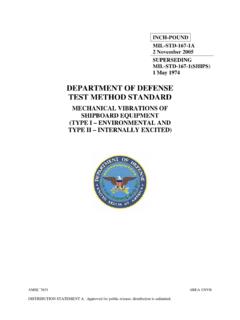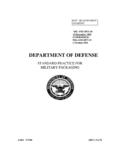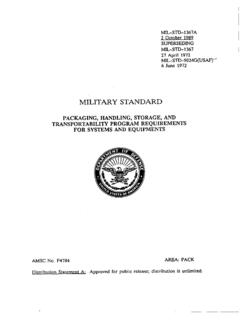Transcription of MIL-STD-648D - Chassis Plans
1 INCH-POUND. MIL-STD- 648d . 10 April 2008. SUPERSEDING. MIL-STD-648C. 11 FEBRUARY 1999. DEPARTMENT OF DEFENSE. DESIGN CRITERIA STANDARD. SPECIALIZED SHIPPING CONTAINERS. AMSC N/A AREA PACK. MIL-STD- 648d . FOREWORD. 1. This design criteria standard is approved for use by all Departments and Agencies of the Department of Defense. 2. This standard establishes the general design criteria and associated tests for specialized shipping containers used by the Department of Defense. The initial step in the creation of a specialized shipping container is to distill the general design criteria within this document into specific design criteria. By filling out a container requirements checklist (see Appendix A) prior to initiating the design, a focused list of unique needs can be identified to ensure that the container's contents are properly protected throughout its planned distribution and stowage logistics. 3. A specialized container is uniquely configured to support and protect its prescribed contents while being handled, stored, shipped to, and unpacked by the user; or to protect personnel and equipment from hazardous contents.
2 Containers of this type frequently incorporate energy absorbing systems, temperature control systems, or special features to make handling or shipment possible, easier, or safer. Engineering drawings, or equivalent, are used to define form, fit, function, materials, tolerances, and manufacturing techniques. 4. A specialized shipping container is designed for use with a specific item when general container specifications are not sufficiently detailed to assure required protection, safety, reliability, maintainability, or configuration control. The need for a specialized container may arise with any deliverable item and invariably does so with nuclear and conventional ammunition and explosives. The container may be the result of a completely original design effort or of the modification of existing or standard container designs. 5. Copies of this standard are available online at or from the Standardization Document Order Desk, 700 Robbins Avenue, Building 4D, Philadelphia, PA 19111-5094.
3 6. Comments, suggestions, or questions on this document should be addressed to Commander, Indian Head Division, Naval Surface Warfare Center, Code E11G3, 4072 N. Jackson Rd, Suite 106, Indian Head, MD. 20640-5114 or emailed to Since contact information can change, you may want to verify the currency of this address information using the ASSIST Online database at ii MIL-STD- 648d . CONTENTS. PARAGRAPH PAGE. 1. 2. APPLICABLE DOCUMENTS ..1. Government documents ..1. Specifications, standards, and handbooks ..1. Other Government documents, drawings, and Non-Government Order of 3. DEFINITIONS ..8. Ambient (temperature) ..8. Anthropometry ..8. Clinch ..8. Commercial-off-the-shelf (COTS) ..8. Competent Connected replenishment-at-sea (CONREP) ..8. Cracking pressure (relief valve) ..8. Cushion (compressive) creep ..8. Distributed isolation material (DIM)..8. Energy absorbing Explosive limit ..8. Faying Fire-retardant materials ..8. Flexible barriers ..8. Fragility Human systems integration (HSI).
4 9. Hydrogen embrittlement ..9. Hygroscopic ..9. Intermediate bulk container (IBC)..9. Level Level B ..9. Life cycle environmental profile (LCEP)..10. Minimum flow rate (relief valve) ..10. Nematode ..10. Non-combustible Non-person portable container ..10. Reseal pressure (relief valve) ..10. Shock response spectrum (SRS)..10. Specialized shipping Springwood ..10. Standard parts and iii MIL-STD- 648d . PARAGRAPH PAGE. Summerwood ..10. Sympathetic detonation ..10. Underway replenishment at sea (UNREP) ..11. Unit Vertical replenishment at sea (VERTREP) ..11. 4. GENERAL Hazardous materials and devices ..11. Contents ..11. Handling equipment ..11. Distribution network ..12. Unit load Configuration ..12. Transportability requirements ..12. Sensitive materials (transportation security) ..12. Transfer-at-sea (UNREP) ..12. Cube and weight ..12. Naval aircraft carrier container size limits ..13. Materials and manufacturing methods ..13. Cadmium-plated hardware ..13. Dissimilar Acceptance criteria.
5 14. Screw threads ..14. Elastomeric parts ..14. Standard parts and Material stability ..15. Internal packaging materials ..15. Materials Blocking and bracing materials ..16. Cushioning materials ..19. Resilient mounts ..20. Dynamic Support fasteners and closure Wood treatment and Nematodes ..21. Nonmetallic materials ..21. Stainless steel ..21. Fire Records receptacle ..21. iv MIL-STD- 648d . PARAGRAPH PAGE. Closure devices ..22. Static electricity ..22. Preservation ..22. Clean-room Security Protection of contents against corrosion and water damage ..23. General ..23. Closed containers without auxiliary barriers ..23. Ventilation ..23. Drainage ..23. Closed containers with auxiliary barriers ..23. Integral-barrier containers ..23. Structural ..23. Leakage ..23. Closures (except removable head drums)..24. Desiccant Humidity Pressurizing Leakage indicator ..25. Container accessories ..25. Transparent window in auxiliary barrier ..25. Special requirements for non-breathing integral-barrier containers.
6 25. Special requirements for controlled-breathing integral-barrier containers ..25. Special requirements for free-breathing containers ..25. Observation Alternate observation window location ..26. Stacking and stowing ..26. General ..26. Stacking stability ..26. Distributed Stacking strength ..26. General ..26. Manual lifting/carrying ..27. Handle Handhold Hoisting ..28. Hoisting Forklift truck compatibility ..29. Containers having a length greater than 88 inches ..29. Containers ranging in length from 50 to 88 Pallet size containers (52 by 44 inches or smaller)..30. Direct interface with military aircraft loading v MIL-STD- 648d . PARAGRAPH PAGE. Secondary uses for fork pockets ..31. Shipboard handling ..31. Handling provision Special protection Temperature control ..32. Field-force Magnetic shielding ..32. Protecting and identifying the container ..32. Painting Identification and instructional Identification marking ..32. Basic instructional Color coding ..33. Container markings.
7 33. Nuclear, biological, chemical (NBC) Human systems integration (HSI)..33. Pallet jack 5. DETAILED Fit and compatibility ..34. General ..34. Fit Mechanical General ..34. Acceptance criteria ..34. Test Temperature combined with Drop surface Repetitive shock Repetitive shock test (stacked) ..36. Drop test (free-fall)..37. Cornerwise-drop (rotational) test ..37. Edgewise-drop (rotational) test ..37. Tipover Impact test ..37. Impact test (stacked)..38. Transfer-at-sea shock Shipboard shock Grades of containers ..39. Classes of containers ..39. Pass-fail criteria ..39. Class I containers (foam or rubberized fiber isolation systems) ..40. Container testing ..40. Weight Size limitations ..40. Testing vi MIL-STD- 648d . PARAGRAPH PAGE. Method of securing the container to the Design Floating shock platform (FSP testing) ..40. Heavyweight shock test ..40. Deck-stowed containers ..40. Method of securing the container to the FSP ..40. Chain tiedown assembly ..40. Class II containers (resilient mount isolation systems).
8 40. Testing to hi-shock events ..41. Chain tiedown assembly ..41. Shipboard shock test (eligibility)..41. Safety drop Railcar shock test for nuclear weapon containers ..41. Vibration ..41. General ..41. Random Truck transportation over Mission/field Aircraft jet ..43. Aircraft propeller ..43. Ship-surface ship ..43. Sinusoidal testing ..43. Resonance survey and dwell test ..44. Sinusoidal cycling Shock mount aging ..44. Salt fog Ozone resistance test ..44. Air-heat aging test ..44. Structural integrity ..44. General ..44. Pressure Test pressures ..45. Leakage integrity ..45. General ..45. Leak test ..45. Test pressures ..45. Superimposed General ..45. Load test (like containers) ..45. Load test (unlike containers) ..45. Hoisting fitting and tiedown attachment points ..45. General ..46. Acceptance Hoisting fittings strength test ..46. Tiedown strength test ..46. Single hoisting fitting strength vii MIL-STD- 648d . PARAGRAPH PAGE. Forklift truck (fully captive fork tine enclosures) compatibility test.
9 47. Forklift truck (non-captive lift) compatibility Handlift truck MK 45 compatibility ..47. General ..47. Static Shock test ..47. Rolling test ..47. Fire performance requirements ..47. Flame spread index test ..47. Smoke density Stacked container fire test ..48. Measurement of magnetic fields ..49. Sympathetic Testing sequences ..49. Army containers ..49. Air Force containers ..49. Navy 6. NOTES ..55. Intended use ..55. Acquisition requirements ..55. Subject term (key word) International standardization agreement implementation ..55. Changes from previous issue ..55. viii MIL-STD- 648d . FIGURE PAGE. 1. Recommended average moisture content for use of wood products in various areas of the United States ..17. 2. Standard fork tine 3. Pallet size container fork tine 4. Samples of symmetrical packaging ..38. 5 Front view of stacked container fire test setup ..48. 6. Plan view of stacked container fire test 7. Test sequence for containers under 150 pounds and issued to ground troops.
10 50. 8. Test sequence for containers 150 pounds or more and issued to ground troops ..52. 9. Air Force test sequence for containers under 150 pounds ..53. 10. Air Force test sequence for containers over 150 pounds ..54. B-1. Records B-2. Center B-3. Sling, hoisting MK 105 MOD 0 ..65. B-4. Sling leg 4,000 pound B-5. Holder, records ..67. B-6. Plug humidity indicator ..68. B-7. Endlift-adapter ..69. B-8. Sling, container lifting MK 109 MOD B-9. Fork pocket (DWG 5167633) ..71. B-10. Fork pocket (DWG 5167693) ..72. B-11. Latch ..73. B-12. B-13. Observation B-14. Access port ..76. B-15. Latch, wide B-16. Shackle ..78. B-17. Valve, B-18. Desiccator ..80. B-19. Latch ..81. B-20. Latch, CRES ..82. B-21. Ring, container lift ..83. B-22. Container endlift interface (sheet 1 of 3 DWG 6214131)..84. B-23. Container endlift interface (sheet 2 of 3 DWG 6214131)..85. B-24. Container endlift interface (sheet 3 of 3 DWG 6214131)..86. C-1. Electrostatic test chamber ..89. C-2. Electrostatic test C-3.



